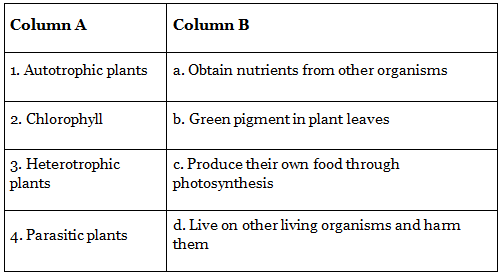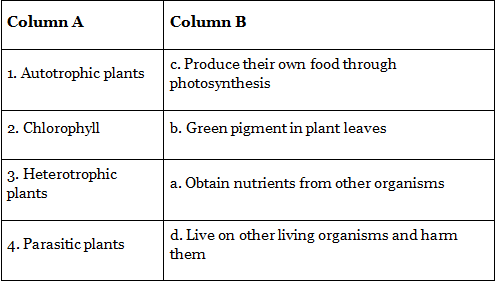Worksheets With Solutions: Nutrition in Plants Class 6 Worksheet Science Chapter 1
Section A: Multiple Choice Questions
Q. 1. Which of the following is not an autotrophic plant?
(a) Algae
(b) Moss
(c) Mushroom
(d) None of the above
Correct Answer is Option (c)
Mushrooms are not autotrophic plants as they cannot produce their own food. They are fungi that obtain nutrients by decomposing dead organic matter.
Q.2. What is the process of making food by the plants called?
(a) Respiration
(b) Photosynthesis
(c) Transpiration
(d) Reproduction
Correct Answer is Option (b)
Photosynthesis is the process by which plants make their own food using sunlight, carbon dioxide, and water.
Q.3. Which of the following is not a necessary condition for photosynthesis?
(a) Carbon dioxide
(b) Water
(c) Light
(d) Nitrogen
Correct Answer is Option (d)
Nitrogen is not a necessary condition for photosynthesis. The necessary conditions are carbon dioxide, water, and light.
Q.4. Which type of nutrition do plants that feed on other living organisms have?
(a) Heterotrophic nutrition
(b) Autotrophic nutrition
(c) Omnivorous nutrition
(d) None of the above
Correct Answer is Option (a)
Plants that feed on other living organisms have heterotrophic nutrition. They cannot produce their own food and depend on other organisms for their nutrition.
Q.5. Which type of plants obtain their nutrition from dead and decaying matter?
(a) Parasitic plants
(b) Saprophytic plants
(c) Insectivorous plants
(d) Symbiotic plants
Correct Answer is Option (b)
Saprophytic plants obtain their nutrition from dead and decaying matter.
Section B: Short Questions
Q.1. Define autotrophic nutrition.
Autotrophic nutrition is the process by which plants make their own food using sunlight, carbon dioxide, and water.
Q.2. Write the equation for photosynthesis.
The equation for photosynthesis is:
6CO2 + 6H2O + light energy → C6H12O6 + 6O2
Q.3. Why is photosynthesis important for living organisms on Earth?
Photosynthesis is important for living organisms on Earth because it produces oxygen and food. Oxygen is essential for the survival of most living organisms, and food produced by photosynthesis is the ultimate source of energy for all living organisms.
Q.4. List the necessary conditions for photosynthesis.
The necessary conditions for photosynthesis are carbon dioxide, water, and light.
Q.5. What is heterotrophic nutrition?
Heterotrophic nutrition is when organisms rely on consuming other living or dead organisms for their nutrition, instead of producing their own food like autotrophs. Examples include animals, fungi, and some bacteria.
Section C: Fill in the blanks
Q.1. The process by which plants make their own food is called ____________.
The process by which plants make their own food is called photosynthesis.
Photosynthesis is the process by which green plants manufacture their own food using carbon dioxide, water, and sunlight in the presence of chlorophyll.
Q.2. The pigment responsible for absorbing light in photosynthesis is ____________.
The pigment responsible for absorbing light in photosynthesis is chlorophyll.
Chlorophyll is the pigment present in the leaves of plants that absorbs light energy from the sun and converts it into chemical energy through the process of photosynthesis.
Q.3. Plants absorb ____________ from the air and ____________ from the soil during photosynthesis.
Plants absorb carbon dioxide from the air and water from the soil during photosynthesis.
During the process of photosynthesis, plants absorb carbon dioxide from the air through tiny pores called stomata and water from the soil through their roots.
Q.4. ____________ plants obtain their food from other living organisms.
Heterotrophic plants obtain their food from other living organisms.
Heterotrophic plants are unable to produce their own food through photosynthesis and obtain nutrients by consuming other living organisms or dead organic matter.
Q.5. The process of photosynthesis takes place in the ____________ of a plant cell.
The process of photosynthesis takes place in the chloroplasts of a plant cell.
Chloroplasts are specialized organelles found in plant cells that contain chlorophyll, the pigment that absorbs sunlight and initiates the process of photosynthesis.
Section D: Match the column
Match the terms in column A with their descriptions in column B.

Section E: True or False
Q.1. Photosynthesis occurs only in the leaves of the plant. ( )
False
Photosynthesis occurs not only in the leaves of the plant but also in other green parts such as stems and young fruits.
Q.2. The primary function of chlorophyll is to provide energy for photosynthesis. ( )
False
The primary function of chlorophyll is to absorb light energy from the sun, which is then converted into chemical energy during the process of photosynthesis.
Q.3. Heterotrophic plants produce their own food through photosynthesis. ( )
False
Heterotrophic plants are unable to produce their own food through photosynthesis and obtain nutrients by consuming other living organisms or dead organic matter.
Q.4. Insectivorous plants obtain their nutrients from dead organic matter. ( )
False
Insectivorous plants obtain their nutrients by trapping and digesting insects, and not from dead organic matter.
Q.5. Symbiotic plants have a mutually beneficial relationship with other organisms. ( )
True
Symbiotic plants have a mutually beneficial relationship with other organisms, where both benefit from the interaction. For example, the nitrogen-fixing bacteria present in the roots of leguminous plants.
|
139 videos|151 docs|18 tests
|






















